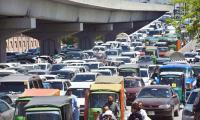HYDERABAD: Fishermen residing in villages near Chotiari reservoir, Sanghar district look happy to have more fish catch this season, but they do not know where to sell it.
These fishing communities have around 1,200 small fishing boats, which they operate on the water body.
Reports gathered from community activists shows that in normal days, traders buy the fish from Chotiari reservoir and neighbouring lakes to sell in major cities of Sindh, Punjab and Khyber Pakhtunkhwa provinces.
With the lockdown in place, the fishermen have more catch, but traders are reluctant to buy fish for the market, leaving the community people in a helpless situation.
Fish caught from the Chotiari reservoir is considered popular because of its taste and quality compared to fish that come to the market from freshwater bodies of the province.
Ramzan Mallah, a community activist residing in Village Phulel, adjacent to the Chotiari reservoir, said it was the only water body, which does not receive contaminated water of factories or municipal waste from towns and cities.
Otherwise, he said fishermen communities of the province have lost many potential water bodies in different areas, which receive industrial as well as municipal waste through canals and drainages. Effluents from factories and municipal sewage poison the water, deplete vegetation cover, and disturb wildlife.
“In Chotiari, since the water is clean, the fish is safe for consumption, thus loved by the people across the country,” he said.
The reservoir covers an area of 18,000 hectares, having water storage capacity of 0.75 million acre feet (maf). The reservoir area has taken over around 60 fresh water lakes existing nearby. Besides this, around one dozen lakes, which were part of the cluster, getting water from the same feeding source have been discarded.
Since these lakes do not have a feeding source from any canal, they are fighting for survival. The government does not seem to have any plan to rehabilitate these freshwater lakes either.
The reservoir receives water through Ranto distributory of Nara canal, which usually brings natural fish seeds and silt to maintain the ecology of the wetland. But the community people said sometimes the reservoir receives more water, in which case they cannot manage to operate boats.
However, when the reservoir does not receive its proper share of water, it reaches dead level.
Community activists said the Inland Fisheries Department under the World Bank-funded project Accelerated Action Plan (AAP) has put around 3.3 million seed in the reservoir this year, which was now ready to catch.
The fishermen are enjoying fish catch, but they are unable to sell the product in the market during lockdown.
There are 1,209 water bodies registered with Inland Fisheries Department-- some of them have a status of being declared Ramsar Sites. But the community people do not have accurate data about the present status of these lakes, as many waters have been discarded and turned in to cesspools and dumping grounds of sugar industries and other pollution sources.
Ramzan Mallah said, “We cannot forget fish catch, chirping birds swinging in grasses, moving fast from one place to another and scenic landscape formed by wandering boats, vegetation and flying birds on the lakes.”
He questioned the kind of development that has harmed the environment. “After much development around us, we cannot imagine what we have gained and lost after building Chortiari reservoir, which we believe has destroyed a source of living for fishermen, farmers and herdsmen,” he added.
Mian M Ali Anjum, conservation officer at WWF Pakistan, who has conducted assessment about the status of habitats of wildlife species in the recent winter (2020) said, “Ups and downs in the reservoir in terms of releasing or stopping water has impacted the ecosystem negatively.”
Sometimes it receives more water, which benefits the fish product occasionally, but the vegetation needs to be rehabilitated to maintain the ecosystem.
The WWF official, quoting his survey findings said the marsh crocodile (Crocodylus palustris), which used to inhabit the area around the reservoir long ago, now seems to have migrated to other neighbouring waters. “Deh Akro 1 and Deh Akro 2-- the cluster of natural fresh water bodies near the reservoir-- were considered safe habitats of crocodiles with little population of threatened smooth-coated otter (Lutrogale perspicillata). Besides this, many other species, including fish and wildlife have shrunk and may have migrated to other waters,” he told The News.
Previous study by WWF-Pakistan conducted in 2008 revealed that Chotiari reservoir was home to different valuable wildlife species, including 14 species of large mammals, 19 species of small mammals, 109 species of birds, 58 species of reptiles and amphibians and about 53 species of freshwater fish. But now after 10-12 years the status of the water body has been changed.
Keeping in mind the importance of tourism, the provincial culture and tourism department has also established some residential huts to facilitate tourists. But the area people said there was need to maintain a unified level of water in every season to maintain the ecosystem.
Especially in the winter, the reservoir and its lakes attract flocks of migratory birds to stay for some time from November till February—March every year.
The reservoir has lost several indigenous fish species, besides disturbing wildlife species due to the rise and fall of the water. Also, the uncertainty of water level increases problems for people who dependent on the reservoir for their livelihood.
The recent study titled “Environmental impact of conversion of natural wetland into reservoir: A case Study of Chotiari reservoir in Pakistan” conducted in 2019 by Mehran University of Engineering and Technology (MUET) showed that the reservoir has caused seepages and devastated agriculture land, inundated natural grass species, trees and ruined the natural rangelands within 5km radius. It has not just impacted the life and livelihoods of fishermen, but also disturbed farmers and herders.
The study recommended taking steps to mitigate the social, economic and environmental impacts of the Chotiari reservoir and take steps to revive the natural ecosystem of the lake.
But, the community activists believe that there was a gap in understanding on the part of government institutions, academia and researchers in realising the share of the ecosystem. They believe that communities were being overlooked in policy-making, management and development decisions.
That was why the country was losing natural resources and ruining sources of livelihoods of hundreds of people, residing along the natural wetlands, besides losing important wildlife species.
A logo of the Advans Pakistan Microfinance Bank Limited seen on a wall.— ADVANS website/file KARACHI: ADVANS...
A Pakistani stock-broker monitors shares prices at the Pakistan Stock Exchange on January 16, 2023. —INPKARACHI: In...
A jeweller waits for a customers at a shop in Karachi on June 26, 2024. — AFPKARACHI: Gold prices increased by...
Muhammad Amin Rajput who has been appointed as acting managing director and chief executive officer of SSGC.— SSGC...
EU flags flutter in front of European Central Bank headquarters in Frankfurt, Germany July 18, 2024. — ReutersMario...
A foreign currency dealer counts US dollar notes at a currency market in Karachi on July 19, 2022. — AFPLAHORE:...







